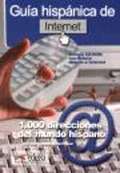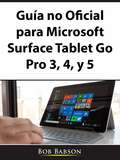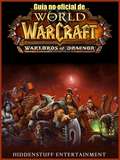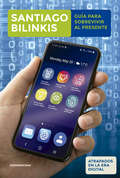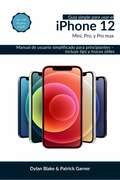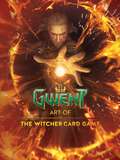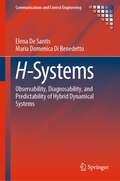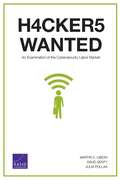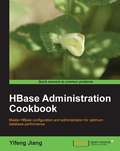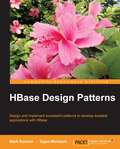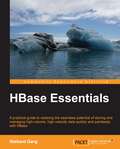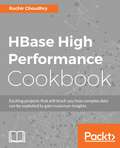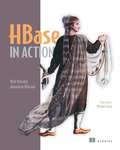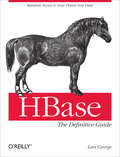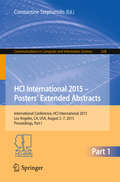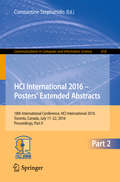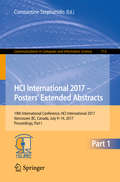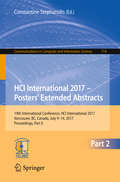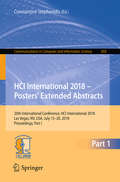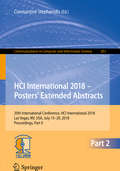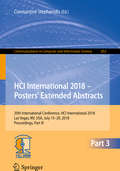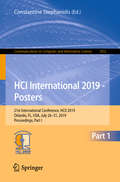- Table View
- List View
Guía hispánica de Internet: 1,000 direcciones del mundo hispánico
by Alfredo González HermosoNo disponible
Guía no Oficial Descargable para Hacks, Mods, Apk, Wiki del Juego Family Guy en Busca de Cosas
by Joshua Abbott Roberto Vega MauryBreve guía descargable con trucos y estrategías para obtener un gran dominio del juego Family Guy: en busca de cosas.
Guía no Oficial para Microsoft Surface Tablet Go Pro 3, 4, y 5
by Bob BabsonAprenda de manera sencilla y rápida como sacar mayor provecho a los dispositivos Microsoft Surface Go Pro 3, 4 y 5, y disfrutar al máximo de sus capacidades y posibilidades.
Guía no oficial de World of Warcraft: Warlords of Draenor
by Isabel Mª Garrido Bayano Joshua Abbott*GUÍA NO OFICIAL* Guía de estrategia y consejos avanzados. Esta es la guía más detallada y completa que encontrarás online. Está disponible para descarga instantánea en tu teléfono móvil, dispositivo eBook o libro de bolsillo. Tras el éxito de mis cientos de guías y estrategias he escrito otra guía profesional avanzada para jugadores nuevos y veteranos. Te proporciona estrategias específicas y consejos sobre cómo progresar en el juego, vencer a tus enemigos, conseguir más monedas, ¡y mucho más! - Consejos y estrategias profesionales. - Trucos y hacks. - Secretos, consejos, trucos y objetos desbloqueables que usan los jugadores profesionales. - Cómo conseguir montones de dinero. - ¡Y MUCHO MÁS! Descargo de responsabilidad: Este producto no está asociado, afiliado, respaldado, certificado o patrocinado por el propietario del Copyright original.
Guía para principiantes. Hacer dinero con tu pequeña empresa en las redes sociales
by Alex Nkenchor Uwajeh E2eLas redes sociales ofrecen gran variedad de posibilidades para pequeñas empresas. No solo son una forma barata de dar a conocer tu marca y tus productos, sino que son también una vía excelente para atraer nuevos clientes. La clave del éxito está en entender las diferentes formas de beneficiarte de cada red social.
Guía para sobrevivir al presente: Atrapados en la era digital
by Santiago BilinkisSantiago Bilinkis aborda en su nuevo libro un tema central del presente: cómo esa supercomputadora de bolsillo que es el teléfono celular está afectando nuestras vidas. El impacto de las nuevas tecnologías sobre el cerebro, la educación, el trabajo y el uso del tiempo libre, bajo la mirada del autor de Pasaje al futuro. ¿Qué impacto tienen los aparatos digitales sobre nuestras vidas?¿Qué efectos produce su uso permanente en nuestros cerebros y los de nuestros chicos?¿Por qué pasamos tanto tiempo atrapados en las redes? Basta alzar la vista para corroborarlo: hoy vivimos mirando el celular. Y no es casual: científicos y empresas trabajan intensamente para aprovechar los últimos avances en neurociencia y psicología y profundizar la dependencia con sus sitios y aplicaciones. Con el objetivo de incrementar sus ganancias, las principales compañías de tecnología se encuentran en una guerra por conquistar nuestro tiempo. Y la están ganando: sin siquiera darnos cuenta, desbloqueamos el celular 120 veces al día. Esta es la primera vez que una herramienta, apenas comenzamos a usarla, empieza a usarnos a nosotros. ¿Cuál es el resultado de esta manipulación? Niños enchufados a las pantallas a edades cada vez más tempranas; redes sociales y aplicaciones de citas que vapulean la autoestima de adolescentes y adultos; numerosas personas que, enganchadas en un consumo maratónico de series, reducen al mínimo su descanso. La tentadora promesa de novedades permanentes esconde una trampa detrás de cada app, a menudo a costa de nuestros intereses prioritarios y hasta de nuestra salud. Develando los mecanismos que han convertido al celular en un objeto irresistible, Santiago Bilinkis propone en esta Guía para sobrevivir al presente una manera apasionante de desbloquear nuestra ingenuidad frente a los dispositivos. Y nos ofrece ideas para utilizar los aparatos digitales para conectarnos y vivir experiencias compartidas en vez de encerrarnos en nuestra propia pantalla. En definitiva, nos invita a recuperar el control sobre la vida personal, familiar y laboral, y así disfrutar de los beneficios y las oportunidades que brinda la tecnología sin quedar atrapados en ella.
Guía simple para usar el iPhone 12, Mini, Pro, y Pro Max: Manual de usuario simplificado para principiantes – incluye tips y trucos útiles.
by Dylan Blake Patrick Garner¿Eres un adulto mayor o alguien que busca una guía fácil paso a paso? Entonces, ¡no busques más! Si estás leyendo esto es porque tienes uno de los más recientes teléfonos insignia de Apple, y ahora que ya tienes esta belleza, es hora de darle buen uso a todo lo que te ofrece, usando un muy bien ilustrado manual de usuario que devela todos sus tips y trucos ocultos. Esta guía ha sido elaborada de forma especial para darte exactamente lo que necesitas, con muchos tips y trucos para ayudarte a familiarizarte con el iPhone 12, el iPhone 12 Mini, el iPhone 12 Pro y el iPhone 12 Pro Max. Si tienes un modelo de iPhone anterior, no tienes por qué sentirte excluido porque también hemos escrito esta guía pensando en ti.Los modelos iPhone 12 tienen incorporadas funciones que te podrían hacer agua la boca. Llevan incluido el nuevo y más rápido chip A14 Bionic, que ofrece una grandísima mejora en rendimiento. Son los primeros teléfonos móviles capaces de grabar vídeo con Dolby Vision en tiempo real, un formato de vídeo profesional. También incorporan pantallas OLED Super Retina XDR con una cubierta Ceramic Shield para mejorar la durabilidad y una protección contra caídas 4 veces mayor. También incorporan los cargadores inalámbricos MagSafe (un sistema de carga inalámbrica magnética) que es dos veces más rápido que los anteriores cargadores inalámbricos Qi. Con este libro podrás aprovechar al máximo todas las funciones y capacidades de tu dispositivo ¡y más! Una vez tengas este libro, aprenderás a: • Encender y configurar tu iPhone • Configurar tus servicios celulares • Instalar una tarjeta nano-SIM física • Configurar un plan de datos celulares con una tarjeta eSIM • Administrar tus planes celulares para SIM doble • Conectar tu iPhone a internet • Cambiar de un dispositivo Android a un iPhone • Administrar la configuración de tu Apple ID y iCloud en el iPhone • Activar y desbloquear tu iPhone •
Guía simple para usar el iPhone 13, Mini, Pro, y Pro Max: Manual de usuario simplificado para principiantes y adultos mayores- incluye tips y trucos útiles
by Dylan Blake¿Eres un ADULTO MAYOR o un PRINCIPIANTE? ¿Deseas sacarle el mejor provecho a tu iPhone? ¡Recibe la ayuda que necesitas con esta guía simplificada! Los nuevos modelos de iPhone 13 vienen repletos de nuevas funciones que puedes utilizar en tu día a día, y este manual de usuario es tu ticket para explorarlas. ¿Quieres usar la cámara de forma más eficiente? ¿Quieres configurar una ficha médica para emergencias? ¿O quieres hacer varias tareas básicas como enviar un mensaje de texto, hacer una llamada, llamar por FaceTime a un amigo, etc.? Entonces, esta práctica guía puede ayudarte con todo eso y mucho más. Al comprar este libro, aprenderás a: • Encender y configurar tu iPhone • Configurar tus servicios celulares • Instalar una tarjeta nano-SIM física • Configurar un plan de datos celulares con una tarjeta eSIM • Administrar tus planes celulares para SIM doble • Conectar tu iPhone a internet • Cambiar de un dispositivo Android a un iPhone • Administrar la configuración de tu Apple ID y iCloud en el iPhone • Activar y desbloquear tu iPhone • Usar gestos y trucos para modelos de iPhone con Face ID • Ajustar el volumen de tu iPhone • Cambiar los sonidos de alertas y las vibraciones de tu iPhone • Buscar configuraciones en tu iPhone • Ampliar el contenido de la pantalla de tu iPhone con Tamaño de pantalla • Abrir apps en el iPhone • Cambiar entre apps • Organizar tus apps en carpetas • Tomar una captura de pantalla o grabar la pantalla en tu iPhone • Bloquear o desbloquear la orientación de la pantalla en tu iPhone • Moverte por la pantalla de fotos de la cámara • Moverte por la pantalla de vídeos de la cámara • Grabar con efecto Cine • Grabar vídeos ProRes • Escanear un código QR con la cámara del iPhone • Ver fotos y vídeos en el iPhone • Eliminar y ocultar fotos y vídeos en el iPhone • Editar fotos y vídeos en el iPhone • Administ
Gwent: Art of The Witcher Card Game
by CD Projekt RedWhether played on the exotic felt tabletop in a palatial casino, or on the rough-hewn bar in a tavern's smoky din, the game of Gwent is never a dull one! With cards that feature fantastic art that only adds to the strategic thrill of crushing one's opponent, Gwent: The Witcher Card Game offers a singular gaming experience. Now, Dark Horse is proud to present each cards' gorgeous artwork in a stunning hardbound volume. Celebrate wondrous artistry and cutthroat gameplay with The Gwent Gallery: Art of the Witcher Card Game!
H-Systems: Observability, Diagnosability, and Predictability of Hybrid Dynamical Systems (Communications and Control Engineering)
by Elena De Santis Maria Domenica Di BenedettoThis book focuses on the observability of hybrid systems. It enables the reader to determine whether and how a hybrid system’s state can be reconstructed from sometimes necessarily partial information. By explaining how available measurements can be used to deduce past and future behaviours of a system, the authors extend this study of observability to embrace the properties of diagnosability and predictability. H-systems shows how continuous and discrete dynamics and their interaction affect the observability of this general class of hybrid systems and demonstrates that hybrid characteristics are not simply generalizations of well-known aspects of traditional dynamics. The authors identify conditions for state reconstruction, prediction and diagnosis of the occurrence of possibly faulty states. The formal approach to proving those properties for hybrid systems is accompanied by simple illustrative examples. For readers who are interested in the use of state estimation for controller design, the book also provides design methods for hybrid state observers and covers their application in some industrial cases. The book’s tutorial approach to the various forms of observability of hybrid systems helps to make H-systems of interest to academic researchers and graduate students working in control and to practitioners using control in an industrial environment.
H4cker5 Wanted: An Examination of the Cybersecurity Labor Market
by Martin C. Libicki David Senty Julia PollakThe perceived shortage of cybersecurity professionals working on national security may endanger the nation's networks and be a disadvantage in cyberspace conflict. RAND examined the cybersecurity labor market, especially in regard to national defense. Analysis suggests market forces and government programs will draw more workers into the profession in time, and steps taken today would not bear fruit for another five to ten years.
HBase Administration Cookbook
by Yifeng JiangAs part of Packt's cookbook series, each recipe offers a practical, step-by-step solution to common problems found in HBase administration. This book is for HBase administrators, developers, and will even help Hadoop administrators. You are not required to have HBase experience, but are expected to have a basic understanding of Hadoop and MapReduce.
HBase Design Patterns
by Mark Kerzner Sujee ManiyamIf you are an intermediate NoSQL developer or have a few big data projects under your belt, you will learn how to increase your chances of a successful and useful NoSQL application by mastering the design patterns described in the book. The HBase design patterns apply equally well to Cassandra, MongoDB, and so on.
HBase Essentials
by Nishant GargWith an example-oriented approach, this book begins by providing you with a step-by-step learning process to effortlessly set up HBase clusters and design schemas. Gradually, you will be taken through advanced data modeling concepts and the intricacies of the HBase architecture. Moreover, you will also get acquainted with the HBase client API and HBase shell. Essentially, this book aims to provide you with a solid grounding in the NoSQL columnar database space and also helps you take advantage of the real power of HBase using data scans, filters, and the MapReduce framework. Most importantly, the book also provides you with practical use cases covering various HBase clients, HBase cluster administration, and performance tuning.
HBase High Performance Cookbook
by Ruchir ChoudhryOver 80 recipes to effectively maximize your system performance with HBaseAbout This BookArchitect a good HBase cluster for a very large distributed systemGet to grips with the concepts of performance tuning with HBaseA pragmatic guide full of engaging recipes and attractive screenshots to enhance your system's performanceWho This Book Is ForThis book is intended for developers and architects who want to know all about HBase at a hands-on level. This book is also for big data enthusiasts and database developers who have worked with other NoSQL databases and now want to explore HBase as another futuristic scalable database solution in the big data space.What You Will LearnConfigure HBase from a high performance perspectiveGrab data from various RDBMS/Flat files into the HBASE systemsUnderstand table design and perform CRUD operationsFind out how the communication between the client and server happens in HBaseGrasp when to use and avoid MapReduce and how to perform various tasks with itGet to know the concepts of scaling with HBase through practical examplesSet up Hbase in the Cloud for a small scale environmentIntegrate HBase with other tools including ElasticSearchIn DetailApache HBase is a non-relational NoSQL database management system that runs on top of HDFS. It is an open source, disturbed, versioned, column-oriented store and is written in Java to provide random real-time access to big Data.We'll start off by ensuring you have a solid understanding the basics of HBase, followed by giving you a thorough explanation of architecting a HBase cluster as per our project specifications. Next, we will explore the scalable structure of tables and we will be able to communicate with the HBase client. After this, we'll show you the intricacies of MapReduce and the art of performance tuning with HBase. Following this, we'll explain the concepts pertaining to scaling with HBase. Finally, you will get an understanding of how to integrate HBase with other tools such as ElasticSearch. By the end of this book, you will have learned enough to exploit HBase for boost system performance.
HBase in Action
by Amandeep Khurana Nick DimidukSummaryHBase in Action has all the knowledge you need to design, build, and run applications using HBase. First, it introduces you to the fundamentals of distributed systems and large scale data handling. Then, you'll explore real-world applications and code samples with just enough theory to understand the practical techniques. You'll see how to build applications with HBase and take advantage of the MapReduce processing framework. And along the way you'll learn patterns and best practices.About the TechnologyHBase is a NoSQL storage system designed for fast, random access to large volumes of data. It runs on commodity hardware and scales smoothly from modest datasets to billions of rows and millions of columns.About this BookHBase in Action is an experience-driven guide that shows you how to design, build, and run applications using HBase. First, it introduces you to the fundamentals of handling big data. Then, you'll explore HBase with the help of real applications and code samples and with just enough theory to back up the practical techniques. You'll take advantage of the MapReduce processing framework and benefit from seeing HBase best practices in action. Purchase of the print book comes with an offer of a free PDF, ePub, and Kindle eBook from Manning. Also available is all code from the book.What's InsideWhen and how to use HBasePractical examplesDesign patterns for scalable data systemsDeployment, integration, and designWritten for developers and architects familiar with data storage and processing. No prior knowledge of HBase, Hadoop, or MapReduce is required.Table of ContentsPART 1 HBASE FUNDAMENTALSIntroducing HBaseGetting startedDistributed HBase, HDFS, and MapReducePART 2 ADVANCED CONCEPTSHBase table designExtending HBase with coprocessorsAlternative HBase clientsPART 3 EXAMPLE APPLICATIONSHBase by example: OpenTSDBScaling GIS on HBasePART 4 OPERATIONALIZING HBASEDeploying HBaseOperations
HBase: Random Access to Your Planet-Size Data (Definitive Guide Ser.)
by Lars GeorgeIf you're looking for a scalable storage solution to accommodate a virtually endless amount of data, this book shows you how Apache HBase can fulfill your needs. As the open source implementation of Google's BigTable architecture, HBase scales to billions of rows and millions of columns, while ensuring that write and read performance remain constant. Many IT executives are asking pointed questions about HBase. This book provides meaningful answers, whether you’re evaluating this non-relational database or planning to put it into practice right away.Discover how tight integration with Hadoop makes scalability with HBase easierDistribute large datasets across an inexpensive cluster of commodity serversAccess HBase with native Java clients, or with gateway servers providing REST, Avro, or Thrift APIsGet details on HBase’s architecture, including the storage format, write-ahead log, background processes, and moreIntegrate HBase with Hadoop's MapReduce framework for massively parallelized data processing jobsLearn how to tune clusters, design schemas, copy tables, import bulk data, decommission nodes, and many other tasks
HCI International 2015 - Posters’ Extended Abstracts: International Conference, HCI International 2015, Los Angeles, CA, USA, August 2-7, 2015. Proceedings, Part I (Communications in Computer and Information Science #528)
by Constantine StephanidisThis is the first volume of the two-volume set (CCIS 528 and CCIS 529) that contains extended abstracts of the posters presented during the 17th International Conference on Human-Computer Interaction, HCII 2015, held in Heraklion, Crete, Greece in August 2015.The total of 1462 papers and 246 posters presented at the HCII 2015 conferences was carefully reviewed and selected from 4843 submissions. These papers address the latest research and development efforts and highlight the human aspects of design and use of computing systems. The papers thoroughly cover the entire field of human-computer interaction, addressing major advances in knowledge and effective use of computers in a variety of application areas. The papers included in this volume are organized in the following topical sections: design and evaluation methods, techniques and tools; cognitive and psychological issues in HCI; virtual, augmented and mixed reality; cross-cultural design; design for aging; children in HCI; product design; gesture, gaze and motion detection, modelling and recognition; reasoning, optimisation and machine learning for HCI; information processing and extraction for HCI; image and video processing for HCI; brain and physiological parameters monitoring; dialogue systems.
HCI International 2016 - Posters' Extended Abstracts
by Constantine StephanidisThis is the first volume of the two-volume set (CCIS 617 and CCIS 618) that contains extended abstracts of the posters presented during the 18th International Conference on Human-Computer Interaction, HCII 2016, held in Toronto, Canada, in July 2016. The total of 1287 papers and 186 posters presented at the HCII 2016 conferences was carefully reviewed and selected from 4354 submissions. These papers address the latest research and development efforts and highlight the human aspects of design and use of computing systems. The papers thoroughly cover the entire field of Human-Computer Interaction, addressing major advances in knowledge and effective use of computers in a variety of application areas. The papers included in this volume are organized in the following topical sections: design thinking, education and expertise; design and evaluation methods, techniques and tools; cognitive issues in HCI; information presentation and visualization; interaction design; design for older users; usable security and privacy; human modeling and ergonomics.
HCI International 2017 – Posters' Extended Abstracts: 19th International Conference, HCI International 2017, Vancouver, BC, Canada, July 9–14, 2017, Proceedings, Part I (Communications in Computer and Information Science #713)
by Constantine StephanidisThe two-volume set CCIS 713 and CCIS 714 contains the extended abstracts of the posters presented during the 19th International Conference on Human-Computer Interaction, HCI International 2017, held in Vancouver, BC, Canada, in July 2017. HCII 2017 received a total of 4340 submissions, of which 1228 papers were accepted for publication after a careful reviewing process.The 177 papers presented in these two volumes were organized in topical sections as follows: Part I: Design and evaluation methods, tools and practices; novel interaction techniques and devices; psychophisiological measuring and monitoring; perception, cognition and emotion in HCI; data analysis and data mining in social media and communication; ergonomics and models in work and training support. Part II: Interaction in virtual and augmented reality; learning, games and gamification; health, well-being and comfort; smart environments; mobile interaction; visual design and visualization; social issues and security in HCI.
HCI International 2017 – Posters' Extended Abstracts: 19th International Conference, HCI International 2017, Vancouver, BC, Canada, July 9–14, 2017, Proceedings, Part II (Communications in Computer and Information Science #714)
by Constantine StephanidisThe two-volume set CCIS 713 and CCIS 714 contains the extended abstracts of the posters presented during the 19th International Conference on Human-Computer Interaction, HCI International 2017, held in Vancouver, BC, Canada, in July 2017. HCII 2017 received a total of 4340 submissions, of which 1228 papers were accepted for publication after a careful reviewing process.The 177 papers presented in these two volumes were organized in topical sections as follows: Part I: Design and evaluation methods, tools and practices; novel interaction techniques and devices; psychophisiological measuring and monitoring; perception, cognition and emotion in HCI; data analysis and data mining in social media and communication; ergonomics and models in work and training support. Part II: Interaction in virtual and augmented reality; learning, games and gamification; health, well-being and comfort; smart environments; mobile interaction; visual design and visualization; social issues and security in HCI.
HCI International 2018 – Posters' Extended Abstracts: 20th International Conference, HCI International 2018, Las Vegas, NV, USA, July 15-20, 2018, Proceedings, Part I (Communications in Computer and Information Science #850)
by Constantine StephanidisThe three-volume set CCIS 850, CCIS 851, and CCIS 852 contains the extended abstracts of the posters presented during the 20th International Conference on Human-Computer Interaction, HCI 2018, which took place in Las Vegas, Nevada, in July 2018.The total of 1171 papers and 160 posters included in the 30 HCII 2018 proceedings volumes was carefully reviewed and selected from 4346 submissions. The 207 papers presented in these three volumes are organized in topical sections as follows: Part I: interaction and information; images and visualizations; design, usability and user experience; psychological, cognitive and neurocognitive issues in HCI; social media and analytics. Part II: design for all, assistive and rehabilitation technologies; aging and HCI; virtual and augmented reality; emotions, anxiety, stress and well-being. Part III: learning and interaction; interacting with cultural heritage; HCI in commerce and business; interacting and driving; smart cities and smart environments.The chapter 'Information at Hand – Using Wearable Devices to Display Task Information in the Context of Industry 4.0' is open access under a CC BY 4.0 license via link.springer.com.
HCI International 2018 – Posters' Extended Abstracts: 20th International Conference, HCI International 2018, Las Vegas, NV, USA, July 15-20, 2018, Proceedings, Part II (Communications in Computer and Information Science #851)
by Constantine StephanidisThe three-volume set CCIS 850, CCIS 851, and CCIS 852 contains the extended abstracts of the posters presented during the 20th International Conference on Human-Computer Interaction, HCI 2018, which took place in Las Vegas, Nevada, in July 2018.The total of 1171 papers and 160 posters included in the 30 HCII 2018 proceedings volumes was carefully reviewed and selected from 4346 submissions. The 207 papers presented in these three volumes are organized in topical sections as follows: Part I: interaction and information; images and visualizations; design, usability and user experience; psychological, cognitive and neurocognitive issues in HCI; social media and analytics. Part II: design for all, assistive and rehabilitation technologies; aging and HCI; virtual and augmented reality; emotions, anxiety, stress and well-being. Part III: learning and interaction; interacting with cultural heritage; HCI in commerce and business; interacting and driving; smart cities and smart environments.
HCI International 2018 – Posters' Extended Abstracts: 20th International Conference, HCI International 2018, Las Vegas, NV, USA, July 15-20, 2018, Proceedings, Part III (Communications in Computer and Information Science #852)
by Constantine StephanidisThe three-volume set CCIS 850, CCIS 851, and CCIS 852 contains the extended abstracts of the posters presented during the 20th International Conference on Human-Computer Interaction, HCI 2018, which took place in Las Vegas, Nevada, in July 2018.The total of 1171 papers and 160 posters included in the 30 HCII 2018 proceedings volumes was carefully reviewed and selected from 4346 submissions. The 207 papers presented in these three volumes are organized in topical sections as follows: Part I: interaction and information; images and visualizations; design, usability and user experience; psychological, cognitive and neurocognitive issues in HCI; social media and analytics. Part II: design for all, assistive and rehabilitation technologies; aging and HCI; virtual and augmented reality; emotions, anxiety, stress and well-being. Part III: learning and interaction; interacting with cultural heritage; HCI in commerce and business; interacting and driving; smart cities and smart environments.
HCI International 2019 - Posters: 21st International Conference, HCII 2019, Orlando, FL, USA, July 26–31, 2019, Proceedings, Part I (Communications in Computer and Information Science #1032)
by Constantine StephanidisThe three-volume set CCIS 1032, CCIS 1033, and CCIS 1034 contains the extended abstracts of the posters presented during the 21st International Conference on Human-Computer Interaction, HCII 2019, which took place in Orlando, Florida, in July 2019.The total of 1274 papers and 209 posters included in the 35 HCII 2019 proceedings volumes was carefully reviewed and selected from 5029 submissions.The 208 papers presented in these three volumes are organized in topical sections as follows: Part I: design, development and evaluation methods and technique; multimodal Interaction; security and trust; accessibility and universal access; design and user experience case studies. Part II:interacting with games; human robot interaction; AI and machine learning in HCI; physiological measuring; object, motion and activity recognition; virtual and augmented reality; intelligent interactive environments. Part III: new trends in social media; HCI in business; learning technologies; HCI in transport and autonomous driving; HCI for health and well-being.
